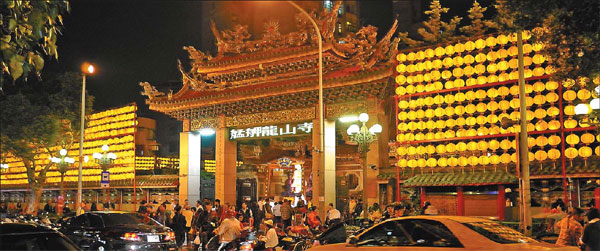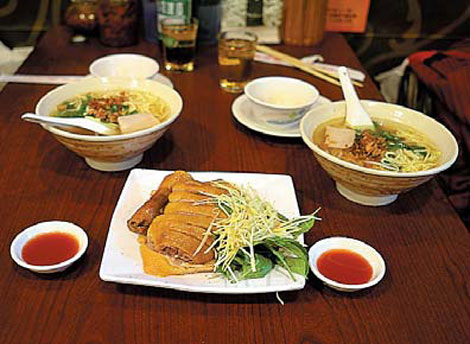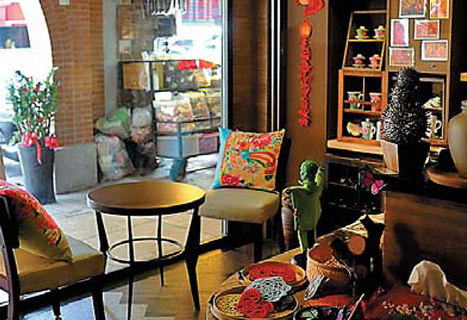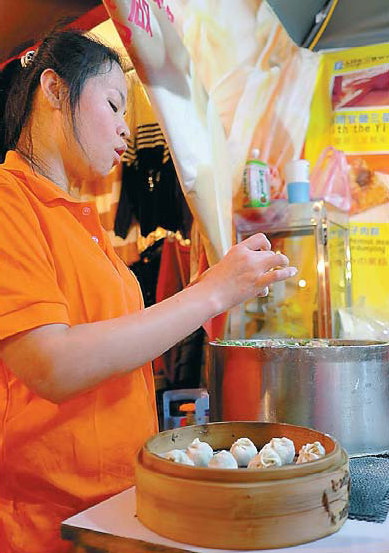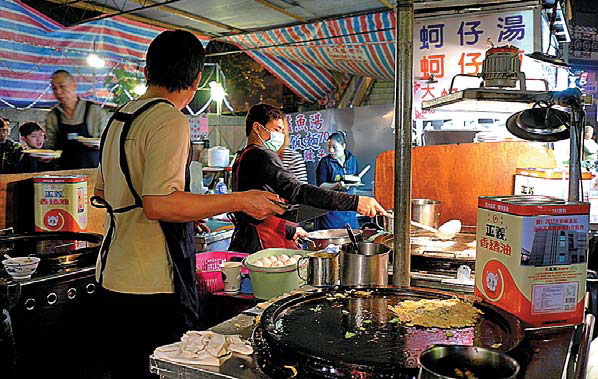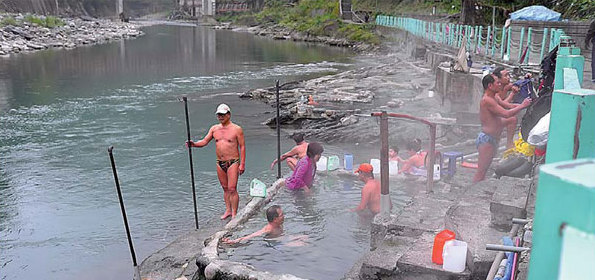Island eats
Updated: 2014-01-12 07:20
By Rebecca Lo(China Daily)
|
|||||||||
|
At the Longshan Temple entrance, many worshippers armed with incense sticks jockey for space among the children posing for photos. Photos by Rebecca Lo / For China Daily |
|
Number 21 Goose and Seafood shop is well-known at 21 Jing Hou Street. |
|
The colorful cushions and full-height window in the Fleisch Cafe add to the ambiance for visitors. |
|
Pork and chive dumplings at the Raohe Street night market attract hungry snackers. |
|
Taiwan's signature oyster omelets at the Guangzhou Street night market. |
|
Wulai village hot spring is the only place in Taipei where a number of public pools are free to enjoy. |
Taipei boasts some of the world's best night markets. Rebecca Lo samples local delicacies in between soaks in the city's natural hot springs.
My fascination with Taiwan began with a boy. Luis and I were in fifth grade together and I thought that he was cute. I finally visited the island of Luis' heritage many years later on a family holiday. My uncle Philip Huang is a former principal in a technical college in Tainan, and he knows the entire island inside out. He and my aunt Georgetta met us in Kaohsiung and we proceeded by minivan to Taichung via the southern routes. We stopped whenever we got hungry, with my uncle ever ready to uncork a bottle of red wine no matter what we were eating.
I hoped to repeat that experience during a return trip, but without all the driving. Taipei is known for its thriving night life and street markets, and I deduced that the best of Taiwan's food scene would be in its capital.
We decided to get an air ticket and hotel package for this trip, and Just Sleep in Ximending was recommended by our travel agent. Although we were surrounded by fellow Hong Kong travelers, I didn't mind hearing Cantonese swirling around me at the breakfast table.
Our room was basic, but had everything that we needed for a long weekend stay. I particularly enjoyed the oversized cartoon graphics that indicated everything from shower and toilet to cup-shaped cutouts in the wall for our mugs.
As I had already been to the somewhat overwhelming Shilin night market, we decided to explore Huaxi, Wuzhou and Guangzhou Street night markets on our first night.
These are somewhat interconnected markets in the city's bustling districts near Ximen. Well traversed by both tourists and locals, within Huaxi's traditional Chinese gates are shops devoted to the restorative properties of turtles and snakes, along with more exotic reptiles.
I wasn't in the mood for snake soup, so we headed to Guangzhou night market for a plate of oyster omelet, among other delicacies. The Fujian specialty is grilled quickly, with the egg batter bubbling away as hungry eyes peered expectantly. I loved its bite of green onion and slurped down my dish almost as soon as it appeared in front of me.
We stopped by Longshan Temple as we continued our journey of food to check out the Chinese New Year decorations. It was resplendently gussied up and many worshippers armed with incense sticks jockeyed for space among the children posing for photos.
The next day dawned bright and sunny, and we decided to walk north from our hotel to Dihua Street market to explore its pre- and post-war architecture. North of Nanjing West Road, there is an eclectic collection of red-brick shop houses and gray concrete buildings with facades ranging from Russian constructivism to pre-war Japanese. Many are on deep lots and reveal a well-manicured courtyard within.
After checking out some fabric boutiques that petered to dried good stores and subsequently into rattan shops, we stopped for a bite at Fleisch Cafe. The colorful cushions in the full-height window caught my eye, and we saw that a beef stew was being lovingly prepared alongside a wide assortment of teas.
As we were waiting for the stew to be ready, we ventured upstairs into the rest of the space. The second story is a large gallery and dining area, while ceramic artist Xu Enguang carved out a studio on the third floor. It turns out that Fleisch is just one part of a cooperative enterprise: Many designers, artisans and craftsmen also use it as a platform for showcasing their ideas.
We were informed that Raohe Street night market is a good one for foodies, and we were not disappointed. I had some of the best pork and chive dumplings imaginable at a little stand there. Sadly, the lines for Taipei's famous pepper buns were much too long for our rumbling stomachs to endure, and we feasted instead on deep-fried milk, spicy chicken salad and ices awash with multi-hued beans and syrups.
On our way back to Just Sleep, we stopped for a nightcap at W Hotel's Woobar. It was full of merry makers, and our hostess suggested we would find it quieter at Wet Bar. The funky interiors overlook the pool area, and we enjoyed watching the groups of hip young things looking fashionably cool while sipping signature cocktails.
For me, a trip to Taipei isn't complete without a soak in its famous sulfuric hot springs. I had already enjoyed the ones in Beitou and its historic Hot Spring Museum, and wanted to try ones further afield.
We made our way south to Xindian, the terminus of the Xindian MRT line. Then, with a little effort, we found the bus that would take us to Wulai village. The district was once dominated by Atayal aborigines, and their handicrafts can be purchased in the village's many shops.
But it was the hot spring that we came for, and we saw from the bridge that there were a row of fleshy folks soaking away alongside the river. We bravely marched there to join them, after shedding our thick garments discreetly behind a makeshift change area further up the hill.
Although Wulai has many hotels and spas to enjoy its waters in comfort, it is the only place in Taipei where a number of public pools are free to enjoy. Wulai's grannies and grandpas swear by the water's restorative properties and recommended that we jump into the river - a cooling 5 C - if we get too hot in the 42-plus C pool.
I turned beet red as soon as my skin hit the water, and we wandered around to find a more comfortable 38 C one to indulge in longer soaks. Welcomed by Wulai water aficionados, we learned that this was a way of life as old as the village itself.
We returned to Taipei for some roast goose at 21 Jing Hou Street - the shop is known as Number 21 Goose and Seafood - and a stroll around Shida night market.
Unlike its siblings, Shida is actually a series of chic boutiques and eateries rather than temporary stalls. Fashion was the prevailing theme here, though there were also a limited number of stalls in case shoppers got hungry.
We finished the evening back at our hotel with a bowl of beef noodles at Lu Wang Kei, one of the city's most famous beef noodles joints. Available in spicy or non-spicy, it was a perfect end to our culinary journey through Taipei.
Contact the writer at sundayed@chinadaily.com.cn.
(China Daily 01/12/2014 page10)
